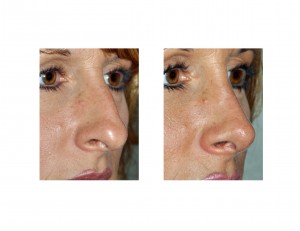Rhinoplasty is well known to be a challenging aesthetic facial procedure. The interactions of the numerous nasal parts and the healing process do not always make for a completely predictable result. The skin of the nose is the one anatomic element that the plastic surgeon can not change and it can frequently lead to undesireable nasal shapes no matter how eloquently the underlying bone and cartilage framework is modified.

In many revisional rhinoplasties, the use of cartilage grafts is critical often more so than in the initial procedure. Such grafts provide structural support to not only provide an improved nasal shape but they also resist scar contracture as it heals over many months. But in secondary rhinoplasty, the septal donor site may be less than ideal. It may have been previously harvested, although some cartilage can always be found, but the graft quantity and length may have been affected. This leaves the plastic surgeon who is performing the secondary rhinoplasty with a difficult task of finding other sources for cartilage grafts and the potential for additional donor site issues.
For all of these reasons, every plastic surgeons strives to perform the first rhinoplasty as best as they can. No patients wants an additional procedure and the technical challenges for the plastic surgeons on re-entry are only slightly less daunting. But despite best efforts, ideal rhinoplasty results do not always occur and a certain percentage of patients will need a second procedure for either aesthetic or functional issues.
What is the predicted incidence of the need for revisional rhinoplasty? The plastic surgery literature has quoted rates of less than 5% to as high as 18%. Most plastic surgeons probably tell their patients that their revision rate is between 5% and 10%, an answer that is not only realistic but perhaps somewhat sobering for the patient.
But the revision rhinoplasty rate is affected by many variables and any % quotation must be taken into context of exactly what type of rhinoplasty is being performed. A most extreme illustration of that point is in the differences between autogenous (your own tissues) and an implant (synthetic material) type rhinoplasty. In certain nasal types (for example Asian and African-American nose), the amount of augmentation that is needed may exceed what is readily available. This has led to the use of alloplastic materials, such as silicone, Gore-Tex, and Medpor which are associated with a higher rate of complications when compared to cartilage grafts. A synthetic material is an additive element to the risks that are already brought into the equation with a fundamentally performed rhinoplasty.
Like all aesthetic procedures, the ‘need’ for a revision of a rhinoplasty can also be matter of perception. Studies have shown that the most common reason given for undergoing secondary rhinoplasty is the development of a new deformity, not just inadequate correction of the initial problem. Other motivations included failure to correct the original deformity, a perceived loss of personal, familial, or ethnic characteristics, the desire for further improvement of an already acceptable result, and a new or unrelieved nasal breathing problem.
Revisional rhinoplasty can be perceived as the need to treat a structural deviation from what the patient expected after surgery. Almost all rhinoplasty results have some imperfections that are tolerated in some patients better than in others. Depending upon the exact nature of the problem, this may be viewed as a complication or as an adverse sequelae. But expectant revisional rhinoplasty rates of 10% to 15% are good numbers that all prospective nose reshaping patients should be aware.
Dr. Barry Eppley
Dr. Jane Namkung
Indianapolis, Indiana


